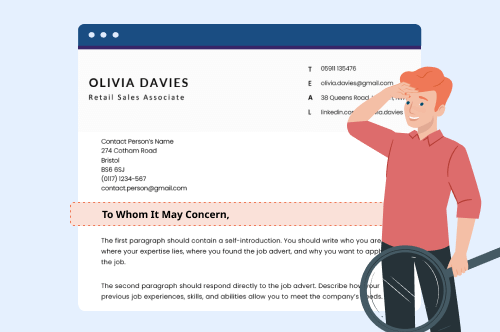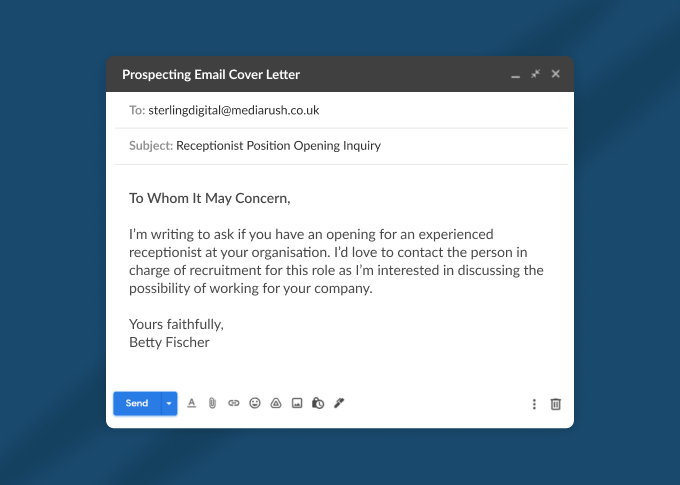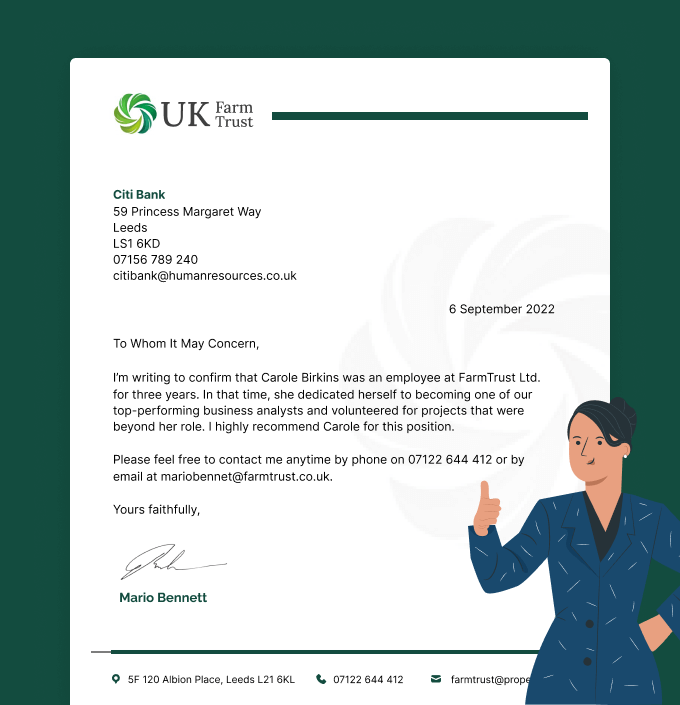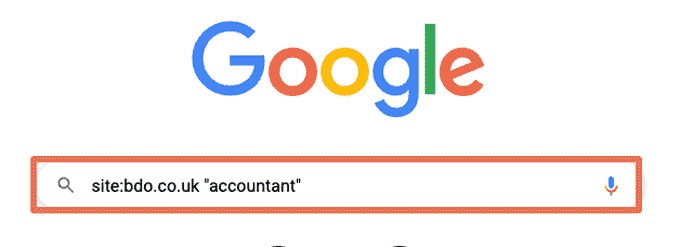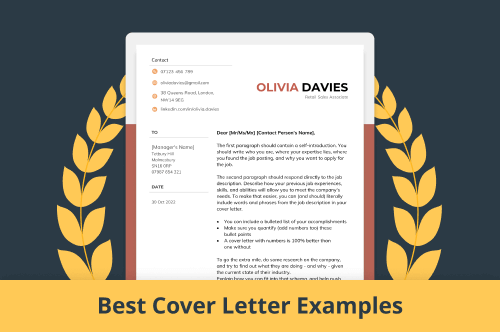When you can’t find the name of a contact person, ‘To Whom It May Concern’ is an acceptable way to start a letter to apply for a job.
However, we first recommend finding the name of a contact and addressing your cover letter to them because using their name:
- makes your cover letter more personalised
- shows you understand professional cover letter writing best practices
- reveals you took the time and effort to research the person and the role
Below, we show you when and how to use ‘To Whom It May Concern’, as well as provide 6 professional alternatives for your cover letter.
When to use ‘To Whom It May Concern’
If you insist on using this outdated phrase, ‘To Whom It May Concern’ is acceptable in only two situations:
1. You’re writing a prospecting cover letter
When you send your job application to companies to see if they have any open positions, you probably won’t have a direct contact person to address.
In a situation where you have no idea who to address or even which department to target, use ‘To Whom It May Concern’ if you can’t find a suitable contact person.
You can also use a prospecting letter (also called a speculative cover letter) to ask for the right point of contact for your application.
Here’s an example of ‘To Whom It May Concern’ in action:
Prospecting Letter Example (Text Version)
To Whom It May Concern,
I’m writing to ask if you have an opening for an experienced receptionist at your organisation. I’d love to contact the person in charge of recruitment for this role as I’m interested in discussing the possibility of working for your company.
Yours faithfully,
Betty Fischer
2. You’re providing a letter of recommendation
If you’re writing a recommendation letter for a former colleague or employee as one of their chosen CV references and don’t know who to address, you can use ‘To Whom It May Concern’. The reader won’t expect you to know whom to address the letter to, and it’s not your responsibility to find out either.
Recommendation Letter Example (Text Version)
To Whom It May Concern,
I’m writing to confirm that Carole Birkins was an employee at FarmTrust Ltd. for three years.
In that time, she dedicated herself to becoming one of our top-performing business analysts and volunteered for projects that were beyond her role. I highly recommend Carole for this position.
Please feel free to contact me anytime by phone on 07351 382 124 or via my email, mariobennet@farmtrust.uk.
Yours faithfully,
Mario Bennett
How to use ‘To Whom It May Concern’ in an email or letter
If you must create a cover letter for an email or one sent by post with ‘To Whom It May Concern’, here’s how to do it properly:
1. Follow formal cover letter formatting
When using formal greetings like ‘To Whom It May Concern’, follow these ways to ensure you properly format your cover letter:
When using ‘To Whom It May Concern’, always:
- capitalise the first letter of every word
- end the phrase with a comma
- start a new paragraph after typing your greeting
When using ‘To Whom It May Concern’, never:
- use awkward variations like ‘Dear Whom It May Concern’, ‘To Whomever It May Concern’, or ‘To Whom This May Concern’
2. Choose the right ‘To Whom It May Concern’ ending
The cover letter greeting you start with will determine how you should end your cover letter.
Use these standard UK letter endings depending on the cover letter introduction you use:
How to find the name of the proper person to address
If the job advert doesn’t include the contact person’s information, try the following:
1. Check the company website
Companies often have an ‘About Us’, ‘Team’, or ‘Company Directory’ page that lists their employees’ names and current job titles.
At a minimum, you’ll find a general information email inbox where you can send a request to learn the name or title of the person you’re addressing your letter to.
2. Do a targeted Google search
Try using Google’s site search operator to find specific information on the company’s website.
Type in this site search format and fill in your target company’s website and job title information, like so:
- site:companyname.com “job title”
- site:companyname.co.uk “job title”
3. Visit the company’s LinkedIn profile
Search for the company’s profile on LinkedIn. On the top of the company’s page is a hyperlink that prompts you to ‘View all [number] employees’.
You can click that link and scan the list until you find the person or job title you want.
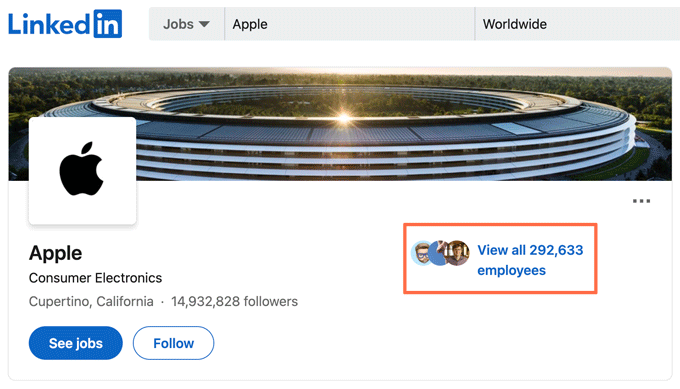
And if the company has thousands of employees, try narrowing your search with the ‘Location’, ‘People’, and ‘Job Title’ filters.
4. Contact the company
Call or email the company to ask for the contact person’s name, job title, and work email address. But don’t forget to explain why you need the information, or you may be confused for a spammer.
Reaching out to the company shows the employer you’re willing to take the initiative and are genuinely interested in the job.
Just remember that emails include your name, so if you prefer to remain anonymous before sending off your application, place a call instead.
Also avoid using the ‘Dear Sir or Madam’ phrase because it’s stiff, outdated, and doesn’t take nonbinary people into account.
6 ‘To Whom It May Concern’ Alternatives
Here are six ‘To Whom It May Concern’ alternatives to use when starting your cover letter:
1. Dear Mr/Ms/Mrs/Miss/Mx [Contact Person’s Surname],
The standard greeting for cover letters is ‘Dear’ followed by your contact person’s title, surname, and a comma.
Below are examples of how to address a cover letter with the contact person’s name:
Dear Mr White,
Dear Ms Rodney,
Dear Mx Taylor,
Remember these points when choosing a title:
- Use ‘Mr/Ms’ if you know the employer’s gender. If a female contact has a preference they’ve mentioned in the job advert, use ‘Mrs’ or ‘Miss’.
- Use ‘Mx’ if the gender of the contact person is unclear, if they have a unisex name like Jessie, Alex, or Jamie, or if they use ‘they’ pronouns. (You can also use ‘Dear [Full Name],’ to avoid offending the reader.)
2. Dear [Job Title],
If you know the contact person’s position but don’t know their name, you can address them by their job title. For example:
Dear Managing Director,
Dear Human Resources Manager,
Dear Human Resources Director,
Dear Customer Service Manager,
Dear Head of Sales,
3. Dear [Department Name],
If you know the name of the department you’re applying to, try addressing your cover letter like this:
Dear Sales Department,
Dear Human Resources Department,
Dear Finance Department,
Dear Customer Service Department,
Dear Marketing Department Manager,
4. Dear Recruiter,
If you’ve done your research and still can’t find a contact name, job title, or department, address your cover letter to the recruiter, like so:
Dear Recruiter,
Dear Recruiting Manager,
Dear Recruiting Team,
5. Dear [Position You Want] Hiring Team,
Beginning your cover letter ‘Dear [Position You Want] Hiring Team,’ is a great way to emphasise the job title you’re seeking.
Here are three examples of how to address the hiring team for your target position:
Dear Graphic Design Specialist Hiring Team,
Dear Accounting Intern Hiring Team,
Dear Marketing Manager Hiring Team,
6. Dear [Creative Nickname],
You can also use a creative nickname to open your cover letter — but only if the job description’s tone and directions make it clear that the recruiter values unique, creative applications.
Creative nicknames instead of ‘To Whom It May Concern’ are also used to start these example cover letters:
Dear Future Boss,
Dear Leader of Data,
Dear David Brent of [Company Name],
FAQs Regarding ‘To Whom It May Concern’
If you’re still unsure of what to write in a cover letter and whether ‘To Whom It May Concern’ is appropriate for your application, here are some frequently asked questions and answers about this phrase.
1. Is it appropriate to use ‘To Whom It May Concern’ in an email cover letter?
Yes, ‘To Whom it May Concern’ can be used if you’re writing a cover letter for your email as an attachment or directly in the body text, just like a traditional cover letter.
However, keep in mind that emails often have a more informal tone, so consider using a more personalised greeting if possible.
2. Is ‘To Whom It May Concern’ suitable for all types of cover letters?
‘To Whom It May Concern’ can be used for many types of cover letters, including job applications, business inquiries, and general inquiries.
However, you should always try and find a specific person to address the letter to if possible, as doing so can increase the chances of your letter being read and considered.
3. How do you properly format ‘To Whom It May Concern’ in a cover letter?
‘To Whom It May Concern’ is typically formatted as the first line of the cover letter, followed by a colon or a comma. Here are two examples:
To Whom It May Concern,
To Whom It May Concern:
